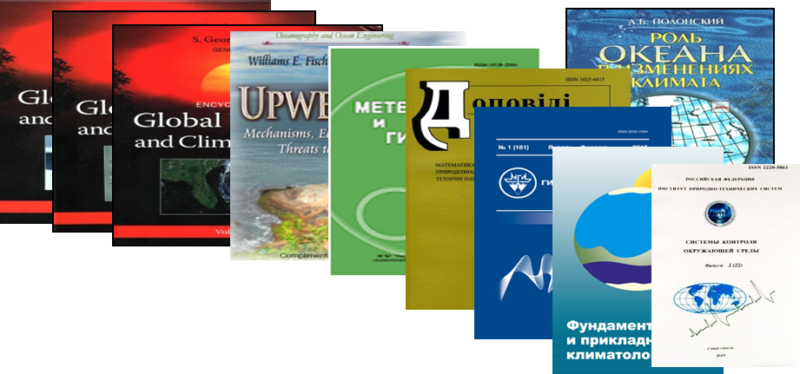Head of the Laboratory
Corresponding Member of the Russian Academy of Sciences, PhD, Professor
Department employees:
Gaisky Vitaly Alexandrovich – ch. sci. employee (Doctor of Technical Sciences, Prof.)
Fedotov Alexander Borisovich – art. scientific employee (Ph.D.)
Melnikova Elena Borisovna – art. scientific employee (PhD)
Averyanova Ekaterina Anatolyevna – scientific employee
Torbinsky Anton Viktorovich – scientific employee
Serebrennikov Alexander Nikolaevich – scientific employee
Sukhonos Pavel Alekseevich – Researcher (Ph.D.-M.N.)
Grebneva Elena Aleksandrovna – Jr. scientific employee
Valle Alexandra Andreevna – Jr. scientific employee
Gubarev Alexey Vladimirovich – leader eng. researcher
Eremeev Leonid Andreevich – leader engineer
Biryukova Maria Andreevna – leader engineer
MAIN AREAS OF WORK
1. Investigation of spatial and temporal variability of meridional circulation and heat transfer, as well as their individual components in the North Atlantic:
– investigation of variability of surface circulation and vertical structure of North Atlantic currents;
– assessment of the contribution of various mechanisms in the formation of integral meridional heat transfer (MPT).
2. Study of climatic variability of the Atlantic-Eurasian region, Arctic and Antarctic:
– study of temperature variability of the upper quasi-homogeneous layer (VCS) of the North Atlantic;
– study of the variability of the shear stress of wind friction, current velocities and their vortices in the North Atlantic;
– study of temperature and precipitation changes in the European region;
– study of the climatic variability of blocking;
– study of the variability of the hydrological and hydrochemical characteristics of the Black Sea;
– study of the ice-thermal characteristics of the seas of the Arctic basin;
– study of the variability of the position of the boundary of the ice edge in the Southern Ocean.
3. Investigation of patterns and mechanisms of formation of regional climatic trends and hydrometeorological anomalies under the influence of global processes in the ocean-atmosphere-lithosphere system:
– investigation of low-frequency variability of meridional thermohaline circulation and heat transfer of the Atlantic and the mechanism of AMO formation;
– study of low-frequency variability of heat and moisture flows at the ocean-atmosphere boundary of the World Ocean;
– assessment of the influence of global climate signals of the SAC, AMO, AC, TDO on the variability of hydrometeorological characteristics of the Atlantic-European region and the Arctic;
– determination of the dependences of the occurrence of anomalies in surface hydrometeorological fields in the Eurasian region on the interannual-decadal variability of large-scale fields of ocean surface temperature;
– study of the influence of low-frequency anomalies of oceanic characteristics on the frequency of blocking in the middle troposphere at different longitudes of the Atlantic-European region and the corresponding changes in the surface fields of air temperature and precipitation;
– study of the influence of the interannual variability of the wind field in the Northern subtropical anticyclonic cycle on the expenses of the Gulf Stream and the Florida current.
4. Numerical modeling of processes in the ocean-atmosphere system:
– investigation of geostrophic currents in the ocean under the influence of wind on the basis of numerical vortex-resolving models;
– assessment of the quality of reproduction of climate changes in surface hydrometeorological fields in the European region based on predictive calculations of global climate models of CMIP3\CMIP5 projects;
– modeling of climatic changes in surface hydrometeorological fields in the Eurasian region, due to large-scale low-frequency anomalies of oceanic characteristics;
– study of the variability of the thermohaline circulation of the North Atlantic using a low-parameter model.
5. Comprehensive interdisciplinary studies of oceanological processes that determine the functioning and evolution of the ecosystems of the Black and Azov Seas based on modern methods of monitoring the state of the marine environment and grid technologies:
– organization of complex ecological, geological and geophysical studies of the coastal territories of Russia, monitoring of their condition, creation of automated measurement databases at stationary landfills;
– monitoring of the coastal zone of the Azov-Black Sea basin: observation systems, GIS technologies;
– oceanographic/climatic geographic information systems (GIS) of the Black Sea.
THE PURPOSE OF THE RESEARCH
Comprehensive interdisciplinary studies of oceanological processes that determine the functioning of the climate system on a scale from global to regional. Regularities and mechanisms of formation of regional climatic trends and hydrometeorological anomalies under the influence of global processes in the ocean-atmosphere system, numerical modeling of the studied processes.
MAIN RESULTS
On the basis of modern long-term data of contact observations (WOCE, RAPID, NOAA, WODB), atmospheric (NCEP/NCAR, ERA40) and oceanic (ORA-S3) reanalysis and direct calculations of heat and mass transfers, the features of spatial and temporal variability were identified and the mechanisms of formation of meridional circulation and heat transfer in the North Atlantic were investigated. The stability of thermohaline circulation in the modern era has been studied using a four–box circulation model and data from the global relief Model (ETOPO2v2) and oceanic reanalysis ORA-S3.
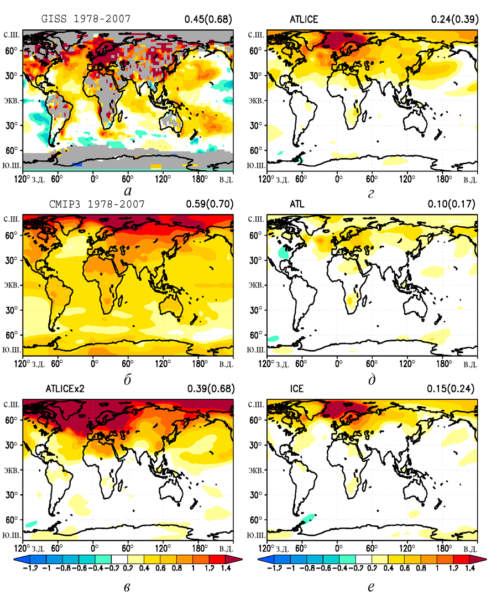
Based on a generalized analysis of estimates of integral meridional heat and mass transfers and their individual components over the past ~ 65 years, the positions of their maxima in the North Atlantic have been clarified and the contribution of various mechanisms to the integral MPT has been estimated. The maximum value (1.4 ± 0.19 HTp) of the integral MPT reaches in the vicinity of 30 ° S. of the Subtropical Atlantic. Near the maximum, the contribution of the horizontal Sverdrup circulation is 40%, and the drift meridional transfer does not exceed 30%. It is shown that nonstationary effects in general do not significantly affect the formation of stationary MPT in the ocean, with the exception of intra-annual variations, which are especially important in the equatorial-tropical zone. The role of vortices in heat transfer increases in the vicinity of the frontal zones and can reach 10% of the integral MPT [Polonsky, Krasheninnikova, 2006, 2007, 2010].
It was revealed that the maximum of the integral MPT in the Subtropical Atlantic is observed in late summer (1.9 HTp), the minimum in spring (0.8 HTp). The amplitude of the annual harmonic of the drift transfer of mass (heat) is maximum at 10 ° C.w. and is equal to ~ 5 Sv (~ 0.5 HT). [Polonsky, Krasheninnikova, 2007]. North of 15 ° C. The role of semi-annual harmonics in their variability increases, and intra-annual fluctuations in wind shear stress, current velocities and their vortices account for ~ 30%, low-frequency (LF) variability ~ 70% of the total dispersion. The maximum LF variability of total turbulent heat flows is observed in winter in the area of formation of the North Atlantic deep water mass [Bazyura (Averyanova), Polonsky, Yurovsky, 2009].
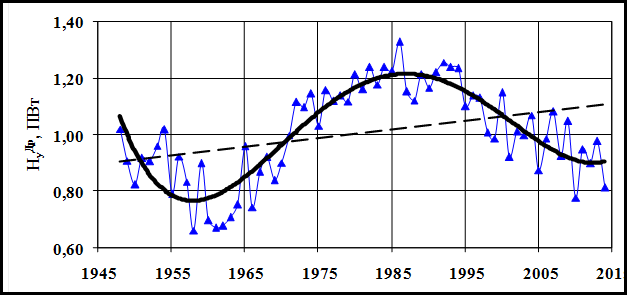
For the first time, based on the analysis of direct estimates of integral mass (heat) transfers and their individual components, it was confirmed that the typical period of their inter–decadal variability in the North Atlantic is ~ 60-65 years. It is shown that these variations are caused by the variability of the zonal wind system of the corresponding scale, which is one of the manifestations of the Atlantic multi–decadal Oscillation (AMO) – the main process in the North Atlantic ocean-atmosphere system of a ten-year scale that determines the climatic changes of the Atlantic-European region; the strengthening of meridional circulation and heat transfer in the North Atlantic in the 60 – 90s is associated with the intensification of the North Atlantic Oscillation (SAC), the strengthening of westerly winds and northeast trade winds, which is accompanied by a shift The northern subtropical anticyclonic cycle (SSAC) in the ocean in the south direction and its narrowing in the meridional direction. Since the 90s, there has been a decrease in the SAC index, a weakening of meridional heat and mass transfers in the North Atlantic, and, accordingly, a shift of the SAC to the north and an increase in its size in the meridional direction [Polonsky, Krasheninnikova, 2015].
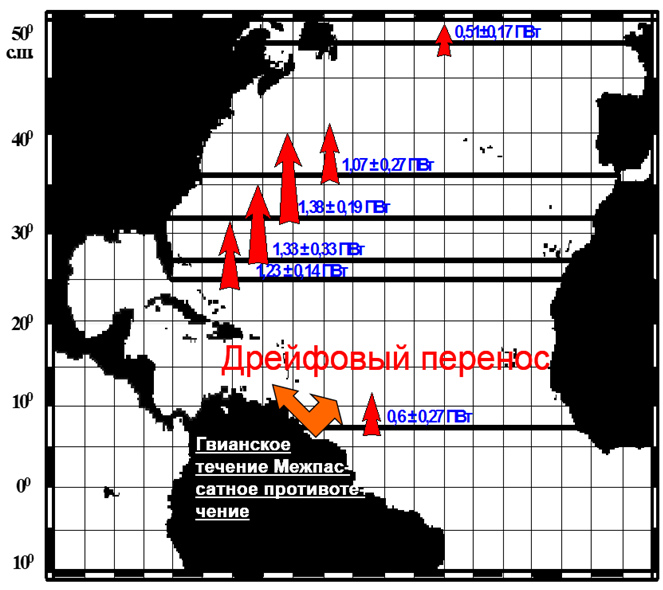
The contribution of heat fluxes at the upper boundary of the upper quasi-homogeneous layer to the low–frequency variability of the temperature of the upper ocean layer is especially significant in the northwestern part of the Subtropical Atlantic and amounts to 30-60%, while advective heat transfer and horizontal mixing play a key role in the evolution of ocean temperature at these scales. The maximum low-frequency variability of total heat flows is observed in winter in the area of formation of the North Atlantic deep water mass [Polonsky, Sukhonos, 2015].
The physical mechanisms that cause intra- and interannual temperature changes of the upper quasi-homogeneous layer (VCS) of the ocean in the North Atlantic are analyzed. It is shown that on an intra-annual scale, all components of the heat budget of the VCS are generally important. At the same time, there are pronounced regional peculiarities in the formation of the seasonal course of the HCC temperature. The average annual heat budget in the VCS is mainly due to the balance of advective heat transfers and horizontal turbulent exchange. The characteristic time scales of variability of advective heat transfers are highlighted. In the area of the Northern Subtropical anticyclonic cycle, interannual variability associated with the North Atlantic oscillation prevails, in the Northern subpolar cyclonic cycle – low-frequency variability of advective transfers with periods of more than 30 years [Polonsky, Sukhonos, 2015].
The main features of the intra-annual variability of the shear stress of wind friction, current velocities and their vortices in the North Atlantic are investigated. It is found that the strengthening (weakening) of the cyclonic vorticity of the tangential friction stress of wind and currents in the subpolar zone occurs in January (July), in the tropical zone — in August – September (January). The strengthening (weakening) of the anticyclonic vorticity of the tangential friction stress of wind and currents in the subtropical zone occurs in January and June – July (May and September – October). It is shown that north of 15 – 20 ° s. w. intra-annual changes in the shear stress of wind friction, current velocities and their vortices generally account for less than one-third of the total variability, the rest of the variance is due to interannual-decadal fluctuations [Polonsky, Shokurova, Sukhonos, 2015].
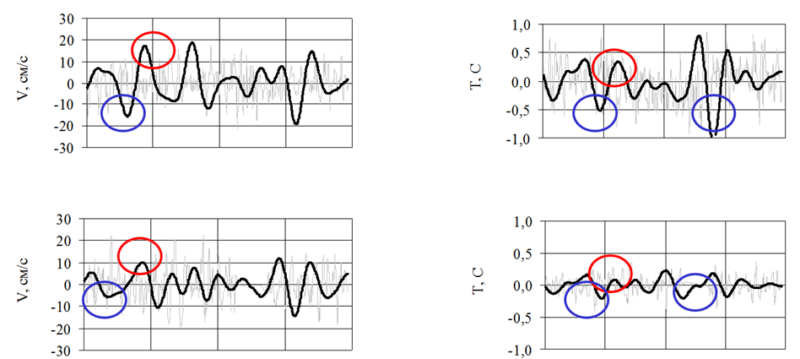
Based on the monthly NCEP reanalysis data for 1948-2012, seasonal features of the spatial distribution of turbulent (explicit and hidden) heat fluxes at the ocean-atmosphere interface were identified, and their low-frequency variability was estimated. The largest values of turbulent heat fluxes at low frequencies were obtained for the winter of the Northern Hemisphere in the North Atlantic in the area of formation of the North Atlantic deep water mass and on the ice edge in the Arctic Ocean. In general, the trends of total heat flows in most of the World Ocean (with the exception of the western parts of the anticyclonic cycles and the tropical zone of the Indian Ocean) are negative. The annual decrease in the inflow of heat into the lower troposphere in the World Ocean as a result of the weakening of the turbulent heat exchange of the ocean with the atmosphere of the same order with the additional influx of heat caused by global warming. Thus, the ocean dampens the warming of the lower troposphere by reducing the total heat fluxes [Bazyura (Averyanova), Polonsky, Yurovsky, 2009].
Based on the monthly NCEP reanalysis data for 1948-2012, the features of the spatial distribution of moisture flows (precipitation minus evaporation) at the ocean–atmosphere interface were identified, their variability on different time scales for the Atlantic Ocean was estimated. The average negative trend of moisture flows in the Atlantic Ocean indicates an increase in the transfer of fresh water from the ocean to the continents. The greatest low-frequency variability of moisture flows is observed for the winter period of the Northern Hemisphere in the vicinity of the East and West Greenland currents and in the western parts of the Atlantic Ocean located between 40°S and 40°S: in the western boundary currents of subtropical cycles in both hemispheres [Averyanova, Sannikov, Polonsky, 2014]
The study of the formation of natural variability of hydrometeorological fields on an interannual-decennial scale in the Atlantic-Eurasian region using observational data and various types of re-analysis has been further developed. New quantitative estimates have been obtained, which confirm that the quasi-decade-long variability of the SAC is a consequence of self-oscillations in the ocean-atmosphere system in the North Atlantic [Basharin, Polonsky, 2009].
It is shown that the stability of the first two modes of the hydrometeorological fields of Eurasia to the climatic shift of 1976-77 is ensured by the stability of the regional influence of the North Atlantic and Southern fluctuations on an interannual-decennial scale. This shift leads to changes in other spatio-temporal modes of air temperature, pressure and precipitation. – It has been established that in winter and spring, the interannual variability of two/four-week fluctuations of the surface air temperature field in Europe is mainly determined by the Southern oscillation, which, with the development of the El Nino event in the Pacific Ocean, leads to an increase in the dispersion of the surface air temperature in the European region.
For the Atlantic-European region, the climatic variability of blocking is analyzed, based on the data of a long-term re-analysis of the twentieth century. The paper considers the influence of ocean surface temperature anomalies on the occurrence of blocking events and determines their manifestations in the variability of surface air temperature and precipitation in the European region.
Based on calculations of global climate models under two greenhouse gas emission scenarios (RCP4.5 and RCP8.5) spatial distributions of future changes in the fields of surface air temperature and precipitation have been obtained, clarifying the published estimates in the European region.
Based on the monthly NCEP reanalysis data for 1950 – 2001, the coefficients of linear trends in the displacement of the ice edge boundary in the Southern Ocean in winter were estimated [Averyanova, Polonsky, Yurovsky, 2009].
During the winter and summer periods, quasi-periodic variability of oxygen concentration with a typical time scale of several decades was found, expressed in the upper 50-meter layer of the Black Sea. In winter, this variability is mainly associated with regional changes in water temperature. In summer (especially on the northwestern shelf of the Black Sea), other factors are also important (variations in river flow, photosynthesis, etc.). [Polonsky, Ogorodova, 2015].
Within the framework of the four–box model of thermohaline circulation, it is shown that the modern climatic epoch is characterized by a quasi-periodic oscillatory regime of THC, manifested in natural climate fluctuations with a period of ~ 60-80 years. The development of a thermohaline catastrophe in this case is unlikely [Averyanova, Sannikov, Polonsky, 2014].
The features of vortex motion in the geostrophic approximation are identified and investigated, their physical interpretation is given [Fedotov, 1988, 1994, 1997].
With the help of the MapInfo GIS program, a map of the functional zoning of the territory of Greater Sevastopol was created; zoning was carried out with the allocation of 11 ecological and geographical areas (EGR) with different structure of nature management, degree of economic load, different environmental conditions using the landscape-geochemical method; the anthropogenic load coefficient was calculated for the selected EGR [Novikova, 2011].
The possibilities of modern GIS programs and their tools that allow collecting into a single database, analyzing and visualizing disparate data on the state of the marine and adjacent air and terrestrial environments are analyzed. For a more detailed assessment and further development of the oceanographic GIS of the Black Sea, the free cross-platform geoinformation system QGIS was chosen [Novikov, Novikova, 2014].
The possibilities of some QGIS statistical modules for solving practical problems of operational assessment of data quality are analyzed, as well as the evaluation of QGIS interpolation modules using kriging methods and radial basis functions when working with a data array of low and normal availability on the example of constructing climatic maps of the water temperature of the surface layer of the Black Sea [Novikova, 2015].
MAJOR PUBLICATIONS OVER THE PAST 30 YEARS

